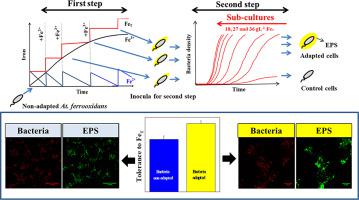当前位置:
X-MOL 学术
›
Hydrometallurgy
›
论文详情
Our official English website, www.x-mol.net, welcomes your
feedback! (Note: you will need to create a separate account there.)
Climbing the hill: The implications of a two-step adaptation on biooxidation of ferrous ion at high total iron concentrations by At. ferrooxidans
Hydrometallurgy ( IF 4.8 ) Pub Date : 2020-11-01 , DOI: 10.1016/j.hydromet.2020.105486 Albert Saavedra , Paulina Aguirre , Juan Carlos Gentina
Hydrometallurgy ( IF 4.8 ) Pub Date : 2020-11-01 , DOI: 10.1016/j.hydromet.2020.105486 Albert Saavedra , Paulina Aguirre , Juan Carlos Gentina

|
Abstract Bioleaching is a process that involves acidophilic and chemolithoautotrophic microorganisms such as Acidithiobacillus ferrooxidans. It is known that At. ferrooxidans undergoes growth and biooxidation inhibition due to ferric ion accumulation. The objective of this study was to establish a strategy to adapt planktonic cells of At. ferrooxidans to high total iron concentrations in two steps and correlate their tolerance to ferric ion with extracellular polymeric substances (EPS) accumulated on the cell surfaces. The first step consisted in carrying out pulse additions of ferrous ion and the second one comprised consecutive sub-cultures with the objective of improving the biooxidation capacity of the bacteria at different concentrations of total iron (18, 27 and 36 g L−1). Visualization and quantification of EPS were assessed through confocal laser scanning microscopy (CLSM). The adapted cells exhibited an increasing volumetric productivity of ferric ion and cell density according to the total iron concentration when adapted and superior to what was showed by non-adapted cells of the control cultures. It was observed that cells adapted to higher total iron concentration displayed the greatest amount of EPS accumulated on their surfaces. Maximum tolerance to total iron of cells adapted to 36 g L−1 was 20% greater than non-adapted cells of the control culture. The experimental evidence points out that EPS accumulation by planktonic At. ferrooxidans was a determining factor for its tolerance to high iron concentrations. Moreover, it is thought that these results could be important in order to increase the efficiency in processes such as bioleaching and biooxidation.
中文翻译:

爬山:两步适应对高总铁浓度下亚铁离子生物氧化的影响。氧化亚铁
摘要 生物浸出是一个涉及嗜酸和化学自养微生物的过程,例如氧化亚铁硫杆菌。据了解,At。由于三价铁离子的积累,亚铁氧化酶会受到生长和生物氧化的抑制。本研究的目的是建立一种适应 At 浮游细胞的策略。氧化亚铁通过两个步骤达到高总铁浓度,并将它们对三价铁离子的耐受性与细胞表面积累的细胞外聚合物 (EPS) 相关联。第一步包括进行亚铁离子的脉冲添加,第二步包括连续的传代培养,目的是提高细菌在不同浓度的总铁(18、27 和 36 g L-1)下的生物氧化能力。EPS 的可视化和量化通过共聚焦激光扫描显微镜 (CLSM) 进行评估。根据适应时的总铁浓度,适应细胞表现出增加的三价铁离子体积生产力和细胞密度,并且优于对照培养物的非适应细胞所显示的。据观察,适应较高总铁浓度的细胞在其表面积累的 EPS 量最大。适应 36 g L-1 的细胞对总铁的最大耐受性比对照培养的非适应细胞高 20%。实验证据表明EPS通过浮游At的积累。氧化亚铁是其耐受高浓度铁的决定性因素。而且,
更新日期:2020-11-01
中文翻译:

爬山:两步适应对高总铁浓度下亚铁离子生物氧化的影响。氧化亚铁
摘要 生物浸出是一个涉及嗜酸和化学自养微生物的过程,例如氧化亚铁硫杆菌。据了解,At。由于三价铁离子的积累,亚铁氧化酶会受到生长和生物氧化的抑制。本研究的目的是建立一种适应 At 浮游细胞的策略。氧化亚铁通过两个步骤达到高总铁浓度,并将它们对三价铁离子的耐受性与细胞表面积累的细胞外聚合物 (EPS) 相关联。第一步包括进行亚铁离子的脉冲添加,第二步包括连续的传代培养,目的是提高细菌在不同浓度的总铁(18、27 和 36 g L-1)下的生物氧化能力。EPS 的可视化和量化通过共聚焦激光扫描显微镜 (CLSM) 进行评估。根据适应时的总铁浓度,适应细胞表现出增加的三价铁离子体积生产力和细胞密度,并且优于对照培养物的非适应细胞所显示的。据观察,适应较高总铁浓度的细胞在其表面积累的 EPS 量最大。适应 36 g L-1 的细胞对总铁的最大耐受性比对照培养的非适应细胞高 20%。实验证据表明EPS通过浮游At的积累。氧化亚铁是其耐受高浓度铁的决定性因素。而且,











































 京公网安备 11010802027423号
京公网安备 11010802027423号